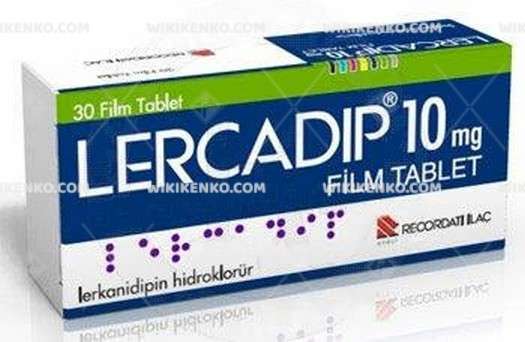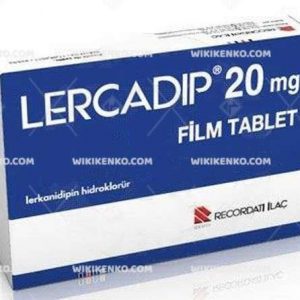Lercadip Film Tablet 10 Mg
In the realm of hypertension management, Lercadip emerges as a potent solution. This film-coated tablet contains 10 mg of lercanidipine hydrochloride, equivalent to 9.4 mg of lercanidipine. Dive into our comprehensive guide to Lercadip and unveil the key to effective blood pressure control.
| Dosage form | |
|---|---|
| Pack size | |
| Potency | 10 Mg |
| Manufacturer | Recordati Ilac |
| Origin | Turkey |
| Generic Name (Ingredient) | Each Film Contains 10.00 Mg Of Lercanidipine Hydrochloride Equivalent To 9.4 Mg Of Lercanidipine. |
Assuming your emergency circumstances for this product, visit Urgent Quotation page. Besides, for any pharmaceutical questions, please ask us in the comments section.
Description
Lercadip belongs to the class of dihydropyridine calcium-channel blockers. Its mechanism of action is rooted in inhibiting the influx of calcium ions through the slow channels of vascular smooth muscle and myocardium during depolarization. This unique action primarily leads to vasodilation, with greater selectivity for vascular smooth muscle over cardiac smooth muscle.
Indications
Lercadip finds its role in the management of mild to moderate essential hypertension in adults. It’s versatile and can be used alone or alongside an angiotensin-converting enzyme inhibitor to address not only hypertension but also chronic stable angina pectoris and Prinzmetal’s variant angina.
Dosage
The recommended dosage for Lercadip is 10 mg orally, administered once a day, ideally at least 15 minutes before meals. Depending on individual patient response, the dose may be adjusted to 20 mg. It’s important to note that dose titration should be gradual, as it may take approximately two weeks before the maximal antihypertensive effect becomes apparent.
Precautions and Contraindications
Caution should be exercised when initiating Lercadip treatment in the elderly and in patients with mild to moderate renal or hepatic dysfunction. Any escalation in dosage to 20 mg daily must be approached with care in these patient subgroups.
However, Lercadip is not recommended for patients with severe hepatic impairment or those with severe renal impairment (GFR < 30 ml/min). Additionally, it should not be administered with grapefruit juice.
Side Effects
While Lercadip is generally well-tolerated, it’s essential to be aware of potential side effects. Most commonly, these are related to the vasodilatory properties of the medication and may include flushing, peripheral edema, tachycardia, palpitations, headache, dizziness, and asthenia. These side effects are often mild, transient, and tend to improve as the body adapts to the medication.
Serious Allergic Reactions: Recognizing the Signs
In rare instances, a serious allergic reaction (anaphylaxis) to Lercadip may occur. Symptoms to watch for include sudden swelling of the lips, mouth, throat, or tongue, difficulty breathing or swallowing, or a swollen, raised, itchy, blistered, or peeling rash. In such cases, immediate medical attention is imperative.
Time to Action and Duration
Lercadip is slowly but effectively absorbed from the gastrointestinal tract. With a total bioavailability of 10%, which can increase to 40% if taken after a fatty meal, the highest blood plasma levels are achieved within 1.5 to 3 hours. This indicates that while its onset of action may not be immediate, it’s crucial to adhere to the prescribed dosing schedule.
Moreover, thanks to its depot effect, a single dose of it sustains its antihypertensive action for at least 24 hours.
Conclusion
In conclusion, Lercadip stands as a valuable ally in the management of hypertension and related conditions. Its unique mechanism of action, combined with a well-defined dosing regimen, offers an effective approach to controlling blood pressure.
However, it’s essential to remain vigilant about potential side effects and seek medical attention if any concerning symptoms arise. Your healthcare provider is your best resource for guidance on hypertension management and the use.
Use the form below to report an error
Please answer the questions as thoroughly and accurately as possible. Your answers will help us better understand what kind of mistakes happen, why and where they happen, and in the end the purpose is to build a better archive to guide researchers and professionals around the world.
The information on this page is not intended to be a substitute for professional medical advice, diagnosis, or treatment. always seek the advice for your physician or another qualified health provider with any questions you may have regarding a medical condition. Always remember to
- Ask your own doctor for medical advice.
- Names, brands, and dosage may differ between countries.
- When not feeling well, or experiencing side effects always contact your own doctor.
Cyberchondria
The truth is that when we’re sick, or worried about getting sick, the internet won’t help.
According to Wikipedia, cyberchondria is a mental disorder consisting in the desire to independently make a diagnosis based on the symptoms of diseases described on Internet sites.
Why you can't look for symptoms on the Internet
If diagnoses could be made simply from a textbook or an article on a website, we would all be doctors and treat ourselves. Nothing can replace the experience and knowledge of specially trained people. As in any field, in medicine there are unscrupulous specialists, differences of opinion, inaccurate diagnoses and incorrect test results.




Reviews
There are no reviews yet.